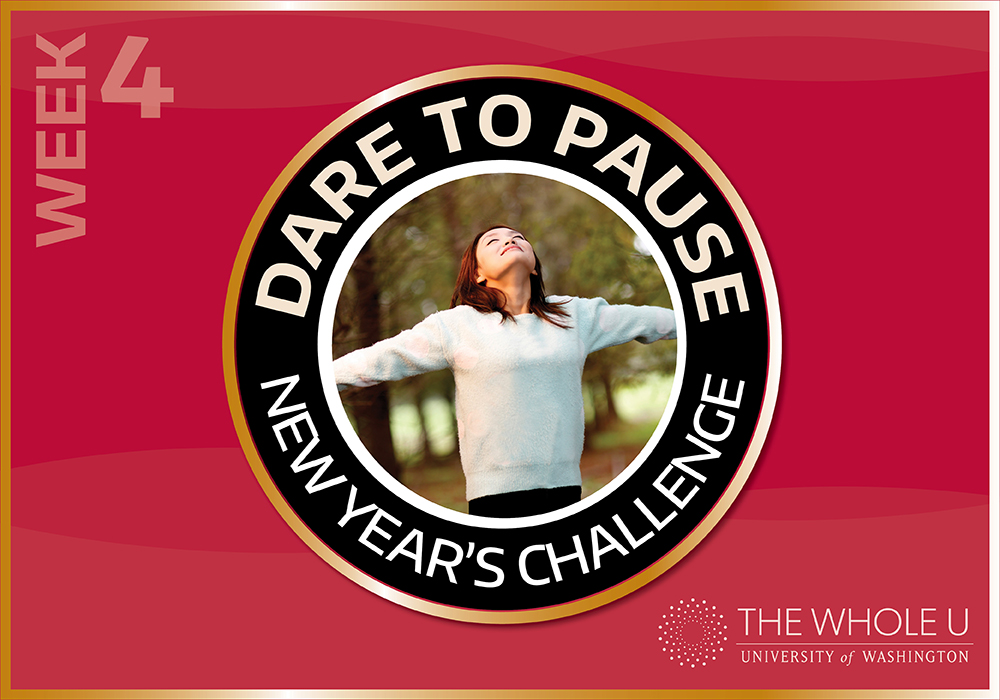
Dare to Pause – Tips to Manage Stress
Ongoing stress can be detrimental to our health and well-being. But whether it’s before an event, an important meeting, a procedure, a presentation, a deadline, or a confrontation, we know stress is part of life. Luckily we can prevent many of its harmful effects with the simple act of taking a pause. Let’s focus on this idea of pausing for week four of the Dare to Do challenge!
Our bodies were designed to handle major stressful events by going into the fight-or-flight response. This is our body’s primitive physiological response to a harmful event or a threat to our survival. Unfortunately many of us stay in this state for prolonged periods of time — whether from internal worry or external circumstance — not realizing the toll this takes on our bodies. Even if we eat well and exercise regularly, not managing stress will catch up with us and we may experience illness, exhaustion, mood swings, or even burnout. (Take a look at this great article by The Mayo Clinic on the effects on our bodies from constant stress).
So, if we know stress is coming, how do we manage it? We breathe. The power of a few breaths before any event can be a game changer. Below are some exercises you can try. Some experts say these exercises are like pressing the reset button on your body.
- Take deep breaths. This evokes the relaxation response. When you breathe deeply with the air coming in through your nose you fill your lungs completely and encourages full oxygen exchange. This will slow your heartbeat and lower blood pressure. Take at least 10 deep breaths to feel a difference. You can do this exercise anywhere and anytime.
- Go for a walk. Many experts state that walking, even if it is for 10 minutes, has the ability to trigger the release of endorphins that stimulate relaxation. Take a short walk before a presentation, walk to your next meeting, or host a walking meeting.
- Get up and stretch. Stress restricts blood flow, leading to knots and tension in your neck and shoulders. Stretching will increase blood flow and improve circulation, which allows your muscles to relax. Stretching also promotes circulation to our brain, which can help with mood and stress. Set an alarm on your watch or phone every few hours and get up and stretch.
- Visualize that peaceful place. Think of a restful place you enjoyed or would like to visit. Close your eyes, take several deep abdominal breaths, and picture yourself in that place. This exercise will slow and deepen your breaths, which in turn stimulate relaxation. This is a good exercise to try immediately after a stressful situation at work.
- Get a plant. Many studies have shown that plants in our homes and workplaces reduce stress and enhance our moods. They also soak up harmful indoor air pollution and improve our air quality. Top choices: The purple waffle plant, English Ivy, Hoya Carnosa, and the Asparagus fern.
These steps seem so easy yet many of us don’t use them. Just like journalist Sydeny Harris said, “The time to relax is when you don’t have time for it.” We dare you to pause and make this part of your daily practice!
3 Thoughts on “Dare to Pause – Tips to Manage Stress”
On February 8, 2016 at 9:14 PM, Abeba said:
Thank you. What a beautiful day!! I went for long walk and felt relaxed after wards and cleaned up my house. thanks for the tips.
On February 9, 2016 at 9:29 AM, Lauren Updyke said:
That is awesome Abeba! I went for a walk this morning too and came back so energized. It is so worth it.
On February 9, 2016 at 2:13 PM, Jo McMillan said:
Back in the 1970’s when I worked as a PT I observed an OT at Children’s Hospital treating a child with cystic fibrosis (CF), tapping her chest in the side-lying position to help remove the excessive lung mucous that is produced in patients with CF, when the child started to regurgitate; the OT instructed the child to wrap her arms around her chest, take a really deep breath, and squeeze her chest with her arms while continuing to hold her breath; I was surprised to see that this action stopped the “up-chuck” response immediately. The OT explained to me that the vagus nerve has receptors in the lung internal surface, and that a really deep, pressured breath is a very effective way to stimulate the nerve strongly, sending an array of stimuli to other body areas; and her subject seemed to verify that. The vagus nerve is a major controller of various components of the stress response. It’s something to think about, and is available to all of us. Jo
Comments are closed.